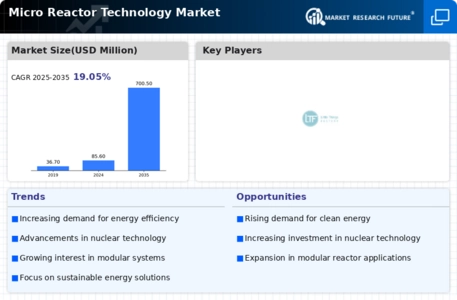Market Trends
Key Emerging Trends in the Micro reactor technology Market
The demand for micro reactors produced through additive manufacturing technology, commonly referred to as 3D printed micro reactors, is experiencing notable growth due to their exceptional properties, including enhanced flexibility, heightened productivity, and increased efficiency. These reactors are garnering attention for their ability to facilitate reactions with minimal or no need for electrolytes. This characteristic results in reduced process costs and simplifies the purification of the compounds generated during these reactions. The distinct advantage of 3D printed micro reactors lies in their capability to be manufactured quickly, taking on various shapes and designs according to specific requirements, all at a comparatively lower cost compared to alternative micro reactors. The evolution of this technology has significantly reduced the time gap between the initial design phase and the functional deployment of the reactor.
One of the noteworthy aspects of 3D printed micro reactors is their capacity to enable full-scale continuous production of fine chemicals and pharmaceuticals. Continuous production, in this context, offers manufacturers several unique benefits that contribute to the growing demand for this technology.
The key driver behind the increasing demand for 3D printed micro reactors is their superior flexibility, providing a versatile platform for various applications. These reactors exhibit a remarkable capability to adapt to diverse shapes and designs, catering to specific needs efficiently. The inherent flexibility of 3D printed micro reactors makes them a preferred choice for industries seeking customizable solutions that align with their unique requirements.
The heightened productivity of 3D printed micro reactors is another factor fueling their demand. These reactors streamline the reaction processes by requiring minimal or no electrolytes. This not only reduces the overall costs associated with the manufacturing process but also facilitates a more straightforward purification of the resulting compounds. The efficiency of these reactors in producing desired outcomes with fewer resources positions them as a cost-effective and environmentally friendly option, aligning with the sustainability goals of many industries.
The reduced time frame for manufacturing 3D printed micro reactors is a game-changer in the industry. The traditional gap between the conceptualization and deployment of reactors has historically posed challenges in terms of time and resource management. With the advent of 3D printing technology, this gap has shrunk significantly, allowing for swift and efficient production. The ability to create functional reactors in a shorter timeframe enhances the overall agility of manufacturing processes, enabling industries to respond promptly to changing demands and market dynamics.
Furthermore, the technology's capability to support full-scale continuous production is revolutionizing the landscape of fine chemicals and pharmaceutical manufacturing. Continuous production offers a seamless and uninterrupted flow of materials, contributing to improved efficiency and consistent quality. Manufacturers benefit from reduced downtime and enhanced control over the production process, leading to increased reliability and productivity.
In conclusion, the growing demand for 3D printed micro reactors is driven by their superior properties, including flexibility, productivity, and efficiency. The ability to adapt to specific requirements, streamline processes, and support continuous production positions these reactors as a valuable asset in various industries. As technology continues to advance, the adoption of 3D printed micro reactors is expected to play a pivotal role in shaping the future of chemical and pharmaceutical manufacturing.


















Leave a Comment